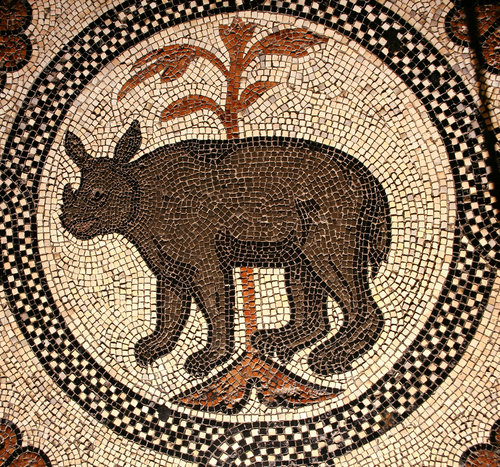About the event
This exhibition and accompanying symposium bring together two unlikely companions: the rhinoceros and the city of Venice. Both events seek to highlight and interrogate the consequences of luxury consumption on an endangered beast and an endangered city.
Every eight hours a rhinoceros is killed to satisfy demand …
Every day an average of 60,000 tourists descend on the city of Venice …
Perhaps surprisingly, this ancient mammal and this shimmering city have a curiously entwined history and current predicament. The rhinoceros is represented in one of Venice’s most ancient mosaics, and an eighteenth-century touring rhinoceros called Clara is famously depicted by Pietro Longhi, one of the city’s great artists.
The rhinoceros is the oldest living mammal; walking the earth for over 50 million years. Venice and its beauty have captured the world’s collective imagination for over 1,500 years. Now both Venice and the Rhinoceros have become victims of their desirability and objectification as luxury objects – both consumed without discrimination by an ever-expanding consumer class.
The horn of the rhino, made of intrinsically worthless keratin, has become one of the world’s most costly luxury objects; an unlikely symbol of status and prestige in a primarily Asian market. Every eight hours a rhinoceros is killed to satisfy demand. The rhinoceros now faces the very real danger of extinction. The city of Venice is overwhelmed each year by a mass tourist market of 30 million people. Every day an average of 60,000 tourists descend on a city with a population of barely 54,000. The effects on the delicately balanced eco systems of the lagoon and of the city have reached a critical level.
In November 2018, an international collaboration of artists, conservationists, poets, writers, and historians, will explore the paradoxical magnificence and fragility of both Venice and of the Rhinoceros. In a symposium designed to launch an accompanying exhibition, they will reveal the history of the artificial construction of rhino horn as a unique object of desire; they will elucidate the tale of Clara the rhino in Venice; they will highlight the distinctive oeuvres of two artists inspired by the rhino; and they will unravel the complex threads involved in the mass tourism market of Venice.
Inspiration for the event comes from a series of encounters between two artists, an historian, and a businesswoman. Gigi Bon with her Studio d’Arte ‘Mirabilia’ has long seen a profound connection between the rhino and her Venetian home. Taiwanese artist Shih Li-Jen has emphasised the connection between the rhino and its consumption in a mainly Asian market. Australian businesswoman Lynn Johnson and her foundation ‘Nature Needs More’ has spearheaded ‘demand-reduction’ campaigns for the consumption of rhino horn in Vietnam and elsewhere. The exhibition and symposium are tied together thematically by the work of Melbourne historian Catherine Kovesi on the longue durée of Luxury and the effects of uncoupling consumption from ethical constraints.
Pietro Longhi, Clara the Rhinoceros, 1751
(Ca’ Rezzonico, Venice)
Rhinoceros, detail from mosaic floor, St Mark’s Basilica, Venice, thirteenth century.
Photo ©Mark Smith
Bernhard Siegfried Albinus, Clara the Rhino and a human skeleton, engraving from Tabuloae sceleti et musculorum corporis humani, 1747.
“Luxury and intrinsic value are not necessarily synonymous. In no object is this better exemplified than the horn of a rhino.”
Exhibition Catalogue
A full catalogue of the exhibition will be available at the Magazzino Gallery, or by contacting Catherine Kovesi
All proceedings of the symposium will be published in 2019 in a special edition of the academic journal Luxury: History, Culture, Consumption to be guest-edited by Catherine Kovesi. Updates will be posted here.



